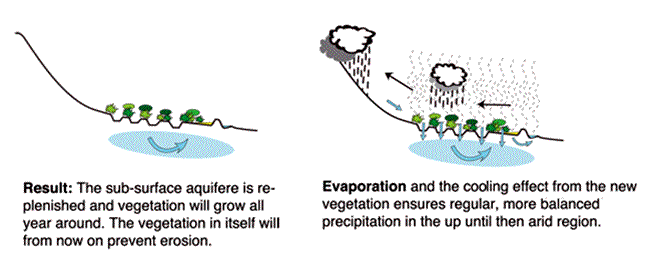Utilising Water Resources Effectively

Water is the most abundant compound (H2O) on the surface of the earth. Without it, life would cease to exist. It is distributed across the earth in the ocean (97.13%), the polar ice caps (2.24%), the groundwater (0.61%), and surface water (0.02%) (Eisenberg & Kauzman, 1973).
The information above tells us that groundwater is 30 times greater than surface water; nevertheless, many people have the perception that surface water occupies a greater volume than groundwater, and remain to believe that rivers and lakes are the only sources of water to depend on for their livelihoods. This is what is happening now and will continue to happen if the poor countries do not gain the technology and funds required to access groundwater. It is not that there is a scarcity of water on this planet as we are always told. There is, however, lack of interest to invest on the utilisation of the groundwater, as water has increasingly become a commodified resource.
For decades Somalia has been affected by frequent droughts, without adequate preparation, it is impossible to prevent the impact of droughts on rural populations. In my teenage years, I remember staying with nomadic communities from my extended family in the rural areas when the schools would close. I recall most men going in search of water during the dry season and walking for at least 20 km daily, loading over 100 litres on the two sides of a camel. Unfortunately, this was not even portable water and sometimes; people would develop all sorts of diseases including deadly cholera.
Somalia, however, possesses huge groundwater resources estimated to be in an area of 12,300km; the volumes of water range from 5,210 to 34,500 Km³. This ranks Somalia as the 14th largest country in terms of groundwater in Africa. This massive presence of groundwater can transform the entire landscape into a green piece of the earth if it is managed properly. Somali communities can be relieved of despair and poverty and enjoy prosperity by utilizing the immense resources the country has. Somalia today is quite different than it was 50 years ago – now it has potential human resources and capital investment than any other time in contemporary history, now there is a great chance moving away from poverty and reclaiming Somali dignity and self-sufficiency.
Exploiting groundwater could drastically reduce poverty, and create a friendlier environment in many parts of Africa, especially sub-Saharan countries. This could be done by encouraging drought-resistant farming, where communities will depend on their local wells to cultivate and raise their livestock hundreds of miles away from the rivers, and that could be the beginning of creating more prosperous and stable communities.
Groundwater is a critical component of water resources management. The Environmental Protection Agency (USEPA 2000) reported that in the United States.Approximately 40% of river flow depend on groundwater, About 50% of Americans obtain their drinking water from groundwater. Approximately 95% of rural residents rely on groundwater for their drinking supply
About 50% of agricultural water comes from groundwater It is essential to improve the water collection capacity of soil in order to tackle desertification and soil erosion. This is achieved with the help of so-called contour trenches. These are trenches that follow the contours of the landscape and capture the rainwater flowing downwards above ground. Using these trenches, destructive above-ground water flows no longer erode the soil; wash away the fertile top soil and any vegetation still present. These trenches mean that water flows underground, resulting in the creation of an underground water supply. This underground water supply is used not only as drinking water by humans and animals, but also stimulates the growth of natural vegetation and of the agricultural crops planted. Besides laying contour trenches, a number of other elements are introduced – stone walls and tree coppicing, for example – which optimizes the effective water-holding capacity of the flow area, erosion is stopped and regulated evaporation is responsible for the achievement of a better local and regional climate.
This new method of continuous contour trenching could have a long-lasting impact to prevent drought, desertification, and food scarcity. Water resources can be renewed by using this technology enabling fresh water not only for human consumption but also for animals and agricultural use.
This multi-functional approach to water and climate management was developed by Peter Westerveld. Since the 1990s, his Trust has successfully transformed this technique into practice by collaborating with local communities in East Africa. In semi-arid areas, the improvement of storing water supplies from underground, free of any evaporation loss, results in the continuous availability of both drinking water and vegetation that is always green. In this way, agricultural production can be increased as part of a sustainable approach. Below are illustrations showing how the contour trenches technology works.


Hagler, A.T., Scheraga, H.A. and Némethy, G., 1973. CURRENT STATUS OF THE WATER‐STRUCTURE PROBLEM; APPLICATION TO PROTEINS. Annals of the New York Academy of Sciences, 204(1), pp.51-78.








